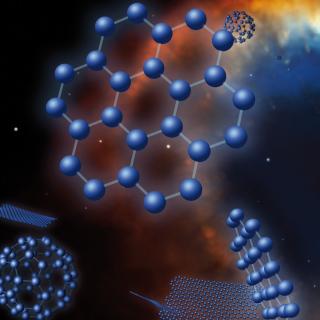Bibcode
Mohorian, Maksym; Kamath, Devika; Menon, Meghna; Ventura, Paolo; Van Winckel, Hans; García-Hernández, D. A.; Masseron, Thomas
Referencia bibliográfica
Monthly Notices of the Royal Astronomical Society
Fecha de publicación:
5
2024
Número de citas
7
Número de citas referidas
3
Descripción
Dusty post-red giant branch (post-RGB) stars are low- and intermediate-mass stars where the RGB evolution was prematurely terminated by a poorly understood binary interaction. These binary stars are considered to be low-luminosity analogues of post-asymptotic giant branch (post-AGB) binary stars. In this study, we investigated the chemical composition of two dusty post-RGB binary stars, SZ Mon and DF Cyg, using multiwavelength spectroscopic data from HERMES/Mercator (optical) and the APOGEE survey (near-infrared). Owing to challenges posed by existing spectral analysis tools for the study of evolved stars with complex atmospheres, we developed E-iSpec: a dedicated spectral analysis tool for evolved stars, to consistently determine atmospheric parameters, elemental abundances, and carbon isotopic ratios. Our abundance analysis revealed that observed depletion patterns and estimated depletion efficiencies resemble those found in post-AGB binary stars. However, the onset of chemical depletion in post-RGB targets occurs at higher condensation temperatures ($T_{\rm turn-off,~post-RGB}\approx 1\, 400$ K), than in most post-AGB stars ($T_{\rm turn-off,~post-AGB}\approx 1\, 100$ K). Additionally, our study resulted in the first estimates of carbon isotopic ratios for post-RGB stars (12C/13CSZ Mon = 8 ± 4, 12C/13CDF Cyg = 12 ± 3). We found that the observationally derived CNO abundances and the carbon isotopic ratios of our post-RGB binary targets are in good agreement with theoretical predictions from the ATON single star evolutionary models involving first dredge-up and moderately deep extra mixing. This agreement emphasizes that in post-RGB binary targets, the observed CNO abundances reflect the chemical composition expected from single star nucleosynthesis (i.e. convective and non-convective mixing processes) occurring during the RGB phase before it is terminated.
Proyectos relacionados

Nucleosíntesis y procesos moleculares en los últimos estados de la evolución estelar
Las estrellas de masa baja e intermedia (M < 8 masas solares, Ms) representan la mayoría de estrellas en el Cosmos y terminan sus vidas en la Rama Asintótica de las Gigantes (AGB) - justo antes de formar Nebulosas Planetarias (NPs) - cuando experimentan procesos nucleosintéticos y moleculares complejos. Las estrellas AGB son importantes
Domingo Aníbal
García Hernández